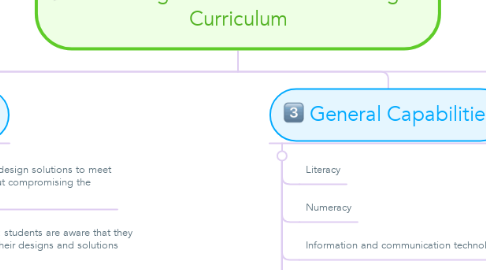
1. Curriculum aims and objective
1.1. Technology over time
1.2. Select appropriate technology to use
1.3. How to approach technological problems with a range of solutions
1.4. Technology and how it affects personal health and well being
1.5. Cross Curriculum Priorities
1.5.1. Sustainability
1.5.1.1. Anticipating and balancing economic environmental and social impacts
1.5.1.2. Create more sustainable patterns for living
1.5.1.3. Develop skills to choose technologies and systems with regard to cost and benefit
1.5.2. Aboriginal and Torres Strait Islander histories and cultures
1.5.2.1. Technologies employed by Aboriginal and Torres Strait Islander people in the past, present and future
1.5.2.2. Worlds first and most continuous culture after developed through intimate knowledge of country/place and culture
1.5.2.3. Explore interconnectedness
1.5.3. Asia and Australia's engagement with Asia
1.5.3.1. Recognise interaction, create need for creative solution and collaboration with others
1.5.3.2. Explore traditional, contemporary and emerging technological achievements in Asia
1.5.3.3. Examine contribution of Asia to technological advances
1.5.3.4. Learning Areas
1.5.3.4.1. English
1.5.3.4.2. Maths
1.5.3.4.3. Science
1.5.3.4.4. History
1.5.3.4.5. Geography
1.5.3.4.6. The Arts
1.5.3.4.7. Health and Physical Education
2. Achievement Standards
2.1. Quality of learning and what students should be achieving and demonstrating at each band level
2.2. Content Descriptions
2.2.1. Describes knowledge, understanding and skills expected to be taught for each year level
2.2.2. Content Elaborations
2.2.2.1. Support material and exemplars of content descriptions for each year level and achievement standard
3. Key Ideas
3.1. Students create and design solutions to meet present needs without compromising the future
3.2. Project management: students are aware that they are accountable for their designs and solutions (OH&S)
3.3. Strands
3.3.1. Knowledge and Understanding
3.3.1.1. 1. Design and technologies
3.3.1.1.1. Use development and impact of technology on life
3.3.1.1.2. Design concepts
3.3.1.2. 2. Digital Techonologies
3.3.1.2.1. Data representation and symbolic strucutre
3.3.1.2.2. Software, hardware and networks
3.3.1.2.3. Use development and impact of information on systems on lives
3.3.1.2.4. Bands
3.3.2. Processes and production skills
3.3.2.1. 1. Design and technologies
3.3.2.1.1. Needs or opportunities
3.3.2.1.2. Develop ideas for designed solutions
3.3.2.1.3. Make and evaluate designed solutions
3.3.2.2. 2. Digital technologies
3.3.2.2.1. Collecting and interpreting data and nature of properties of data
3.3.2.2.2. Use range of digital systems
3.3.2.2.3. Identify problems and implement solutions
3.3.2.2.4. Communicating online and interacting safely and appropriately
4. General Capabilities
4.1. Literacy
4.2. Numeracy
4.3. Information and communication technology
4.4. Critical and creative thinking
4.5. Ethical understanding
4.6. Intercultural understanding
4.7. Bands
4.7.1. Overview of content in each year level/band
4.7.1.1. Foundation to Year 2
4.7.1.2. Year 3 and 4
4.7.1.3. Year 5 and 6
4.7.1.4. Year 7 and 8
4.7.1.5. Year 9 and 10
4.8. Student Diversity
4.8.1. Students with disabilities
4.8.1.1. Can adjust learning with use of extended general capabilities, learning continuum in literacy, numeracy and personal and social capability
4.8.2. English as a second language or dialect
4.8.2.1. Additional support for English as a second language or dialect- teacher resources
4.8.3. Gifted and talented
4.8.3.1. Use higher order thinking and/or focus on cross curricula priorities
4.8.3.2. Draw on later band levels
